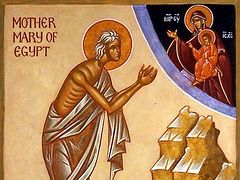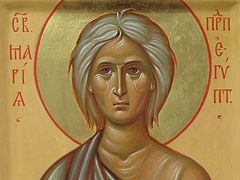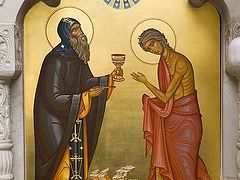In the Russian Church tradition, the Thursday of the Great Canon has an additional folk name of the "Standing of St. Mary of Egypt". It is called that because the congregation stands throughout the long service (aside from prostrations or bows from the waist are not being made, or kneeling at certain hymns), and keeps vigil. It also implies the firm stand against temptations that St. Mary took in the Egyptian desert.

For the last time in this Great Lent we have read the canon of repentance of St. Andrew of Crete, and on our souls lie the holy words of repentance: “Have mercy on me O God, have mercy on me.” We heard also the refrains: “Holy Father Andrew pray to God for us! Holy Mother Mary, pray to God for us!”
Repentance is how we’ll be saved. No matter what good deeds we might have done, by boasting in them we turn into Pharisees who look only at externals, while inside we are like tombs filled with all sorts of filth. For we are not justified by works of the law; no one is able to do such works as would cover our evil deeds. Repentance is higher than everything. Many have attained salvation through repentance.
The Church offers for our attention the Life of St. Mary of Egypt. The once great harlot became through repentance a great saint. Repentance requires labors from us that our good deeds do not.
Only some seem to think that it is easy to repent. Repentance is unbelievably hard work. Repentance does not consist in saying, “I repent!”—even while calling out for God’s help. In vain are those deceived who think that after naming our sins at confession we don’t need to do anything more. Naming the sin is only a good beginning, but enormous labor is ahead... Without that labor our words could remain just words.
But saying that first word with resolution means very much. There will be many and various seductions along the way, but we need to remember that first word.
St. Mary of Egypt performed so many acts of fornication that it was hard for her to talk about them later with the ascetic Zosimas. She thought that sin was pleasure and that it would open doors for her everywhere. But she ran into her first barrier when she wanted to enter the church on the feast day—a human wave pushed her back, and she saw in this the punishing hand of God. She prayed to the Most Holy Theotokos, and She helped her enter the church to venerate the Life-Giving Cross of the Lord. After bowing down before it, she firmly resolved to abandon sin, and without giving it a second thought set out for the desert. She spent seventeen years in fornication, and forty-seven years in repentance. No matter what temptations she experienced she overcame them all through God’s help.
God’s help is not what God will do for us, as the folk sayings go. God helps those who do something themselves. When Mary of Egypt was nearly overcome by temptations, she fell down on the earth and prayed. And what do we do in such situations?
Let’s talk about our prayer. We not only pray negligently, but we don’t even always pray—and we have no fewer temptations than St. Mary of Egypt had. In the desert of our life also lurk temptations that perhaps even the ancient ascetics did not see. But we have to overcome them.
The ascetics who passed through the way of repentance and gained experience will help us. And here is the first one to help us—St. May of Egypt. When she prayed, St. Zosimas saw how she rose above the ground. The strength of her prayer gave her repentance, and repentance provides the wings for hovering above the ground. Only through repentance can we be delivered from sins. And we have an abyss of sins.
Why aren’t we horrified by this abyss? Because we don’t see it. If we were to see this abyss, with what strength would we cry out, “Have mercy on me O God, have mercy on me!”
We are often slow to repent. Let’s just sin a little bit more and then we’ll repent. That calculation is deceiving. “O my soul, rise up, why art thou sleeping? The end is near!” we sing in the Great canon. Our life is quickly growing shorter, and the end is very near. We must not put off repentance, for we may not have time.
Let’s break with sin just like St. Mary of Egypt, who crossed the Jordan just as soon as she made her resolve. Why are you taking your time? “Just one more gulp!” And what if that gulp proves to be fatal?
Repentance leads us to resurrection. This is the fifth week of Great Lent, just a little more and it will be Pascha, the Resurrection of Christ. Pascha is not an earthly festival, Pascha is a heavenly festival, and we have to prepare for it in a heavenly way, through repentance.
So let’s ask ourselves: Which sin did we break with this year? Without breaking with sins we will not see Pascha, though we might reach it in the earthly way.
Pascha is freedom from sins, our peacemaking with God and with each other.
Let us hasten to fill in our gaps.
Have mercy on me, O God, have mercy on me! Holy Mother Mary, pray to God for us! Amen!



